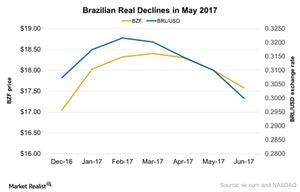Slumping Commodity Prices Pressure the Brazilian Real in 2Q17
The Brazilian real dropped ~2% in May 2017 amid the country’s ongoing political instability.
June 27 2017, Updated 9:08 a.m. ET

The Brazilian real’s performance
Brazil’s (EWZ) economy once again is engulfed by political scandals and corruption, which have been impacting its growth over the last three years. The Brazilian real (BZF) has been declining since the allegations of corruption by President Michel Temer surfaced in March 2017.
The decline in commodities (DBC) and oil prices (USO) are also adding to the ordeal, pressuring the real against the US dollar (UUP) in May 2017. The chart below illustrates the recent performance of the real.
The real’s performance in May 2017
As we can see in the chart above, the real has been on a downtrend since the allegations of corruption against Temer gained strength in March 2017. The real dropped ~2% in May 2017 amid the country’s ongoing political instability.
Political stability is crucial for a healthy investment climate in any country. In Brazil’s case, political uncertainty has led investors to exit the country’s markets, impacting its asset performance.
The pace of foreign direct investments has declined in the first four months of 2017. The net foreign direct investment inflows in April 2017 decreased 71% compared to the same period in 2016. The country’s net foreign direct investments stood at $774 million in the first four months of 2017.
Decline in commodities and oil in 2Q17
The decline in commodities prices seems to be exacerbating the drop in the Brazilian real. The price of commodities and currency of commodity export–dependent economies are highly interconnected. Also, the price of the commodity tends to influence the domestic currency.
Other Latin American (ILF) currencies affected by declining commodity prices include the Colombian peso and the Mexico peso.
In our next article, we’ll look at inflation in Brazil.
